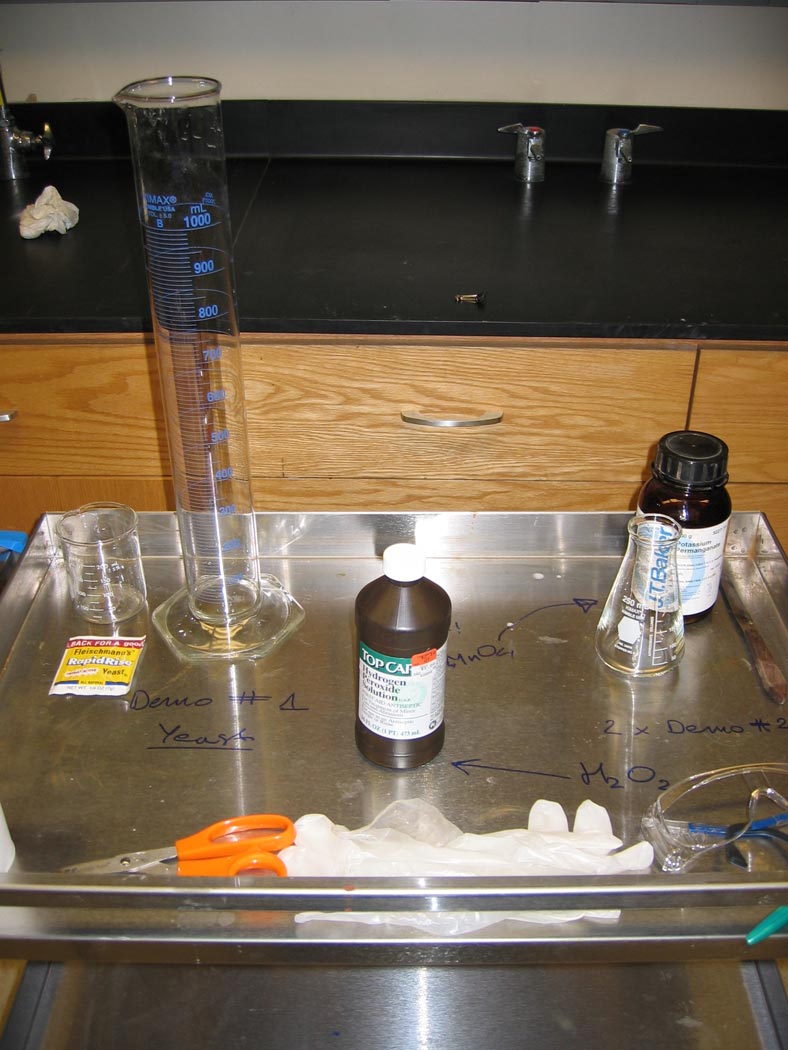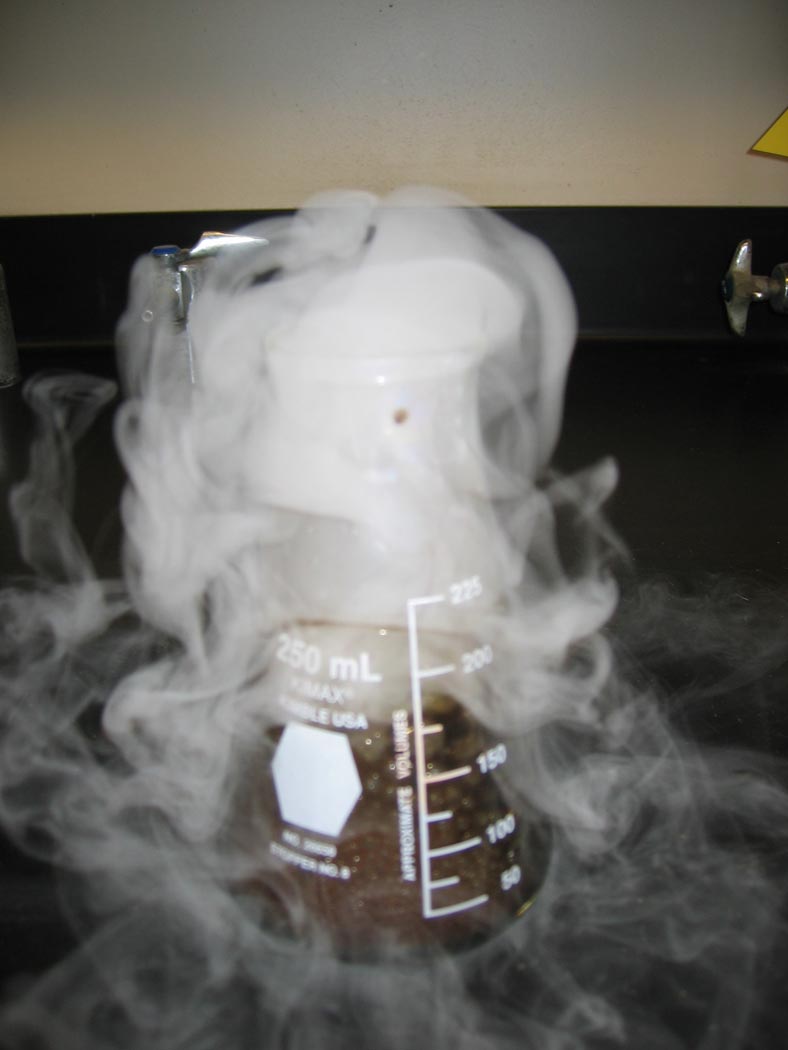Catalysts in inorganic chemistry and the chemistry of life
 The decomposition of hydrogen peroxide is examined "as is" and in the presence of inorganic and enzyme catalysts.
The decomposition of hydrogen peroxide is examined "as is" and in the presence of inorganic and enzyme catalysts.
Ingredients: hydrogen peroxide, potassium permanganate, yeast
Procedure: A complete recipe follows.
1. Observe the decomposition of hydrogen peroxide in an Erlenmeyer flask.
2. Observe the same reaction upon the addition of crystals of potassium permanganate.
3. Observe the same reaction on the addition of yeast.
Understanding: A catalyst is a substance that leads to an increase in the rate of a chemical reaction, but does not effect the state of equilibrium between the reactants and products. While the catalyst participates in the reaction, influencing the rate of reaction and even the mechanism, it is neither consumed nor produced. At the end of the reaction, the catalyst may be recycled.
The notion of a "catalyst" is over two centuries old. While the great chemist Jons Jacob Berzelius is commonly credited with the first recognition of a catalyst, in 1836, there is evidence that the first suggestions of an understanding of catalysis were made by Mrs. Elizabeth Fulhame, in 1794, in her book "An Essay on Combustion." Berzelius and others imagined that catalysis would be an "only rarely observed force which is probably active in the formation of organic substances." However, Fulhame considered the possibility that all reduction/oxidation reactions require water as a catalyst. In doing so, she imagined a role for catalysis that was much more modern, extending to inorganic as well as biochemical reactions.
 The decomposition of hydrogen peroxide is a reduction/oxidation disproportionation reaction with products of water and oxygen gas
The decomposition of hydrogen peroxide is a reduction/oxidation disproportionation reaction with products of water and oxygen gas
H2O2(aq) → H2O(l) + O2(g)
The reaction is exothermic and occurs at a noticeable rate in the absence of a catalyst, where the rate of reaction can be followed by monitoring the volume of oxygen gas produced as a function of time.The addition of the inorganic catalyst manganese(IV) oxide leads to a substantial enhancement in the rate of reaction. The reaction can also be catalyzed by the addition of copper(II) oxide or zinc oxide. The manganese(IV) oxide produces the greatest enhancement in the rate of reaction, with zinc oxide leading to the smallest enhancement in the rate of reaction.
In our demonstrations, we observed the rapid decomposition of hydrogen peroxide on the addition of crystals of potassium permanganate. As the decomposition reaction is exothermic, the solution is heated during the reaction producing a "cloud" of water vapor that is expelled from the flask.
The identical decomposition of hydrogen peroxide is also catalyzed by the protein catalase, an enzyme found in the cells of plants and animals. Catalase catalyzes the conversion of hydrogen peroxide, which can be dangerous to cells, to water and oxygen. It is know to be a near perfect enzyme as the catalytic efficiency is so great that it is believed that essentially every time a substrate molecule encounters the enzyme, a reaction occurs!
How does enzymatic catalysis work? Let's consider a simple reaction mechanism where the substrate, S, reacts to form product, P
S → P
In the presence of a catalyst enzyme, E, the reaction proceeds in two steps. In the first step, the substrate binds to the active site of the enzyme, forming the enzyme-substrate complex, ESE + S → ES
The rate at which ES is formed will be diffusion limited, limited by the time required for the randomly diffusing enzyme and substrate to find each other in solution.In the second step, the substrate reacts to form product and the enzyme and product separate
ES → E + P
The overall reaction converts substrate to product. The enzyme-substrate complex is an intermediate, and the enzyme itself is a reactant and product, unaltered by the overall reaction.
 We combined hydrogen peroxide with yeast to observe the dramatic effect of catalase in decomposing the hydrogen peroxide, leading to the creation of a substantial amount of oxygen gas that is trapped in a rising foam of yeast and solution.
We combined hydrogen peroxide with yeast to observe the dramatic effect of catalase in decomposing the hydrogen peroxide, leading to the creation of a substantial amount of oxygen gas that is trapped in a rising foam of yeast and solution.
For the enzyme to effectively catalyze the reaction, the activation energy for the reaction in the presence of the enzyme, ES → EP, must be lower than the activation energy for the reaction in the absence of the enzyme, S → P. How does the enzyme lower the activation energy for the reaction?
It was Linus Pauling who first understood the mechanism of catalysis at the molecular level. In 1946 he wrote that "The only reasonable picture of the catalytic activity of enzymes is that which involves an active region of the surface of the enzyme which is closely complementary in structure not to the substrate molecule itself in its normal configuration, but rather to the substrate molecule in a strained conformation corresponding to the activated complex." That is, an enzyme acts by selectively binding the transition state structure of the substrate better than it binds the reactant in its unstrained reactant conformation. In doing so, the enzyme lowers the activation energy for the reaction and enhances the reaction rate.
Another important invention that was born from Pauling's work on catalysis was the concept of catalytic antibodies. In 1969, William Jencks imagined that "If complementarity between the active site and the transition state contributes significantly to enzymatic catalysis, it should be possible to synthesize an enzyme by constructing such an active site. One way to do this is to prepare an antibody to a haptenic group which resembles the transition state of a given reaction. The combining sites of such antibodies should be complementary to the transition state and should cause an acceleration by forcing bound substrates to resemble the transition state." That ability to create catalytic antibodies has been demonstrated experimentally in the laboratories of Peter Schultz and Richard Lerner, making the speculations of Pauling and Jencks a reality.
Rates of catalysis are influenced by the form of the catalyst
Question: The decomposition of hydrogen peroxide is catalyzed by the addition of potassium permanganate. The rate of reaction is observed to be greatly enhanced by the addition of an aqueous solution of permanganate as opposed to the addition of permanganate crystals. Explain this observation.
You can check your answers here.
You can check your answers here.
Enhancements in the rate of reaction
Question:
A chemical reaction studied at a temperature of 38C is found to have a reaction rate that is enhanced by a factor of 400,000,000 when compared with the uncatalyzed reaction. In Pauling's view, the catalyst acts by lowering the energy of the activated complex, or transition state, relative to the reactant state. Assume that the increase in the rate is entirely due to a lowering of the energy of the activation complex. What is the change in the activation energy due to the stabilization of the transition state by the enzyme?